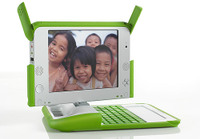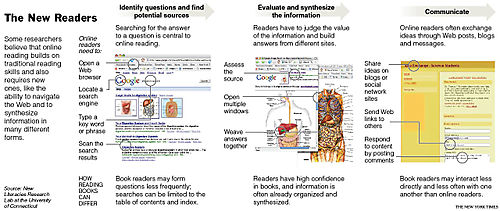As teenagers’ scores on standardized reading tests have declined or stagnated, some argue that the hours spent prowling the Internet are the enemy of reading — diminishing literacy, wrecking attention spans and destroying a precious common culture that exists only through the reading of books. … But others say the Internet has created a new kind of reading, one that schools and society should not discount. The Web inspires teenagers who might otherwise spend most of their leisure time watching television, to read and write. …Clearly, reading in print and on the Internet are different. On paper, text has a predetermined beginning, middle and end, where readers focus for a sustained period on one author’s vision. On the Internet, readers skate through cyberspace at will and, in effect, compose their own beginnings, middles and ends. More Literacy_Debate_Online,_RU_Really Reading? 120KB pdf
One to One Computing Goes Global – “Give 1, Get 1”
 It turns out that the revolutionary XO, the much-touted “$100 laptop,” costs nearly $200. But for a limited time you can donate one to a third world child and get one free for yourself. Plus T-Mobile is offering donors one year of complimentary HotSpot access good for the XO laptop, and any other WiFi enabled device. The program is called “Give 1, Get 1,” you pay $400 and One Laptop Per Child (OLPC) donates a laptop to a deserving child. By Christmas, you get an XO laptop plus an $200 tax deduction.
It turns out that the revolutionary XO, the much-touted “$100 laptop,” costs nearly $200. But for a limited time you can donate one to a third world child and get one free for yourself. Plus T-Mobile is offering donors one year of complimentary HotSpot access good for the XO laptop, and any other WiFi enabled device. The program is called “Give 1, Get 1,” you pay $400 and One Laptop Per Child (OLPC) donates a laptop to a deserving child. By Christmas, you get an XO laptop plus an $200 tax deduction.
OLPC states that the goal is:
One learning child. One connected child. One laptop at a time.
The mission of One Laptop Per Child (OLPC) is to empower the children of developing countries to learn by providing one connected laptop to every school-age child. In order to accomplish our goal, we need people who believe in what we’re doing and want to help make education for the world’s children a priority, not a privilege. Between November 12 and November 26, OLPC is offering a Give One Get One program in the United States and Canada. During this time, you can donate the revolutionary XO laptop to a child in a developing nation, and also receive one for the child in your life in recognition of your contribution. More
David Pogue of the New York Times gives the XO a great review and writes, “it’s a laptop that’s tough and simple enough for hot, humid, dusty locales; cool enough to keep young minds engaged, both at school and at home; and open, flexible and collaborative enough to support a million different teaching and learning styles.” More plus a video demo
Better hurry, the program ends November 26 and OLPC says that this is the only time these laptops will be available to the general public.
It’s about Rigor, Relevance AND Relationships
In May of this year I ran a two-day workshop for the social studies department at New York City’s High School for International Business and Finance. We focused on rigor and relevance and explored a variety of strategies that enable the student to “do the work of the historian.” More
I was pleased to see the school profiled on the front page of today’s New York Times “The High School Kinship of Cristal and Queen.” PDF version: Download Cristal-Queen.pdf
The feature dealt with the struggles and accomplishments of two recent graduates.
"By the time Cristal and Queen were freshmen, their math and reading skills were well below grade level, and school administrators considered them 'at risk': at risk of failing and dropping out. The high school, with graduation rates higher than the citywide average, turned out to be a place where they discovered talents and aspirations they never knew they had. 'They turned on the switch,' Cristal said. 'It’s like my brain opened up.' ”
Cristal reminds us of the importance of the “three R’s” – rigor, relevance and relationships. Students need a rigorous program with challenging goals and effective feedback. A focus on relevance helps students to better understand themselves as learners and measure progress towards their goals. But most critical, are supportive relationships with educators who can provide the scaffolding that students need to take responsibility for their learning.
I’m grateful to have had the chance to meet the teachers, administrators and support staff that make the New York City’s High School for International Business and Finance an effective small learning community. Read the NY Times article and view the audio slide show “The Kinship of Cristal and Queen.”. … See for yourself.
Literacy Strategies for the Multi-Ability Classroom: Part I
I recently presented a workshop for teachers from the New York State Office of Children and Family Services. The goal was to share strategies for working with struggling readers in multi-ability classrooms in juvenile detention facilities around the state. I used reader profiles to guide teachers through identification of struggling readers and appropriate learning strategies. Here are tri-folds of three types of struggling reader. Non-Reader, Word Caller and Turned Off. (each a 200kb pdf) Print them out back to back. Developed with Pat Martin. Reference: Differentiated Instructional Strategies for Reading in the Content Area, Carolyn Chapman and Rita King
I was joined by Suzanne Suor, a learning specialist who focuses on motivating struggling readers through the use of student publication projects. This spring we will be working with OCFS teachers from across the state in staff development training. We plan to collect samples of student work to review the impact of our literacy strategies in the classroom. We’ll combine strategies, student work and teacher reflection in publications to share with the students and their families.
This dedicated group of teachers has a commitment to helping their students build motivation, positive self image and academic skills. They already have many great project ideas for student publications – example teen fathers writing and publishing their own books for their children. For more on professional development with a product see PowerPoint overview. (400kb pdf)
For more strategies see: Literacy Strategies for the Multi-Ability Classroom: Part II

